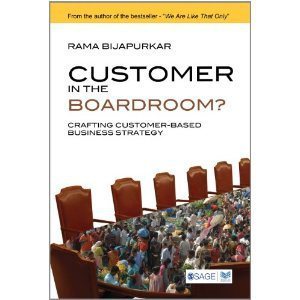Raj Shankar's Blog, page 59
February 14, 2013
On Entrepreneurship: In What Lies an Entrepreneur’s Joy?
Many times small business owners start with the enthusiasm and gradually lose steam. They almost do the business more as a routine way of earning the needed wealth. There is no joy or thrill in running the venture. 
This leads to the question – where does the entrepreneur derive joy from? Is it the activity or the result? Drawing on ancient wisdom stated in so many texts, and essayed beautifully in Bhagavad Gita, joy cannot be derived from the outcome for longer periods. Be it name, fame, wealth or any other aspect. For how much ever you have, there would be someone or something that is one notch above us. This leads us to a fundamental perspective – that joy has to come from the act of doing and not from the results of the act.
It is then important for an entrepreneur to find area based on his or her nature which could be made useful to someone. The venture should be anchored in dynamics that supports the nature and preferences of the entrepreneur. The purpose of the venture should be tied to what the entrepreneur cherishes and wants to do. This alone will ensure despite the crests and troughs of entrepreneurship, the entrepreneur will wake up each morning wanting to do more of what he is doing.
This then is the real meaning of what people call joy of work. It is all the more important for an entrepreneur because they in turn serve as an inspiration to many others around them. Taking the entrepreneurial route is good for every one of us – but it has to be taken in the real sense, for the thrill of doing what you love doing. Any successful entrepreneur’s story (not just the popular ones) will stand testimony for this!


February 13, 2013
On Innovation: Many Small Steps, One at a Time
When I was invited to speak at the DMI College of Engineering this week, I happened to talk to a bunch of students from both bachelors and masters level courses in Engineering and Technology. I shared with them my thoughts on creativity and the art of coming up with ideas.
bachelors and masters level courses in Engineering and Technology. I shared with them my thoughts on creativity and the art of coming up with ideas.
When one of the students asked me if he can think of entrepreneurship without that single out-of-the-box idea, it got me thinking! Is innovation only for companies like Apple and Google? Is innovation only for people like Steve Jobs and Mohammed Yunus? I think it is for everyone. Every little improvement, every little advancement, every little progress is innovation maybe on a smaller scale. It is many small steps that take you to the possibility of a paradigm shift.
The message I left for the students was to make progress one step at a time. I asked them to keep attempting to figure problems in the world and come up with solutions one at a time. It may be an idea that solves only a part of the equation – so be it! When they do this regularly, they will start with simple solutions, but along the way, their ideas will get better. Archimedes did not come up with the idea of buoyancy suddenly – neither was it his first bath! Staying with the problem as he lived his life made the solution build up in his mind over time. Every single small improvement in thought must have led him to suddenly discover that big shift. In a similar manner when a student keeps working on the challenge, problem, or subject of his interest – there will be many small ideas that will come along. He / She has to learn to accept it and build on it. As they stay with the problem and keep coming with number of ideas, at some point they will come up with a break through idea.
The best part is they will never know which one it is for a long time after they have come up with it. But if one is courageous to come up with it and make the world a better place, they will be remembered. If not directly, definitely through their product or service! So keep ideating for no idea is good or bad, its just one more along the way…


February 12, 2013
Vedantic Wednesday: Don’t Blame the darkness, Open your Eyes
“It is sure to be dark if you close your eyes.” – Chinese Proverb.
This captures the reason why we are not experiencing the Self. If the sun is rising in the east, but we stand facing the west, how will we experience the sunrise? In a similar fashion because our focus is totally directed towards the ‘anatman’ and the external objects, we fail to experience the Self present as ‘Atman’ within us.
To experience our true nature, our uncorrupted SELF, we need to turn our attention inwards. We need to search for answers to the doubts that we have about external world, inside us. For example if you are disappointed because you cannot afford Mont Blanc pen, instead of fixing the cause on the cost of Mont Blanc, you may want to investigate from where this unhappiness is arising in you.
By directing our gaze inwards through contemplation and meditation we will be able to train our mind to catch glimpses of the eternal truth that enlivens us. But if we are going to be searching for answers outside, however hard we may search and however long we may search – answers will elude us.


February 11, 2013
On Strategy: Organize Before Growing
Last week I happened to conduct the pre-conference workshop at ISBA 2013 conference at Bhubhaneswar. During the  workshop and numerous times post the session I had people walk up to me and ask about scaling their operations/business. They shared with stories of repeated failed attempts and wanted to know what aspect of it could have gone wrong. While we did have discussions on the challenges as much as time would permit–most of them were taken by surprise by one of my comments.
workshop and numerous times post the session I had people walk up to me and ask about scaling their operations/business. They shared with stories of repeated failed attempts and wanted to know what aspect of it could have gone wrong. While we did have discussions on the challenges as much as time would permit–most of them were taken by surprise by one of my comments.
I told them if they have not organized themselves for scaling or growth – no amount of their efforts is going to yield any results. At the most they can expect ‘spikes’ but not sustainable and even growth.
Organizing comes before figuring a formula for growth. Once you have figured a market/opportunity to go after, you need to look at your business design and ask yourself if the business can take on the pressure of growth evenly – or will it get skewed and collapse?
While some may ridicule this as just a theoretical thought, I have personally seen it help some of our clients to scale sustainably. During my strategy engagements I have had my CEO’s and Entrepreneurs sit down to re-look at their design and subsequently their plan for possible growth. This has made them see options that were not there before and also understand the weak points in the business design that was coming in the way of sustainable scaling.
Hence before you decide to scale – relook if you are organized for scale. If not do that first and then begin…


February 10, 2013
On Leadership: Where is the Lid?
During the 3 days at ISBA 2013 conference, I came across numerous leaders, doctorates, scholars, teachers, policy makers, incubator managers and entrepreneurs. In many different ways they all made references to creating leaders in the Indian  entrepreneurship ecosystem. As in many other areas in India, this ecosystem also requires strong visionary leaders to pave the path. While a lot of aspects were discussed one particular issue stood out – mindset. Without exception most speakers and practitioners (off the stage) shared the feeling! Without a change in mindset most policies, strategies, plans are not going to work. This is because a 5 Litre container can only take 5 Litres of milk. If you want it to pour more you need a bigger container. This means lifting the lid to a greater height.
entrepreneurship ecosystem. As in many other areas in India, this ecosystem also requires strong visionary leaders to pave the path. While a lot of aspects were discussed one particular issue stood out – mindset. Without exception most speakers and practitioners (off the stage) shared the feeling! Without a change in mindset most policies, strategies, plans are not going to work. This is because a 5 Litre container can only take 5 Litres of milk. If you want it to pour more you need a bigger container. This means lifting the lid to a greater height.
So, one of the things that leaders need to do is increase their capacity to take on more. This will only arise as a result of changing your mindset. To do this one needs to explore newer avenues, tread un-walked paths, question the accepted, apply differential thinking etc. This means we need more entrepreneurial leaders. The question is can we create them? How?
I came away from the conference with great hopes for a stronger India. It also gave me re-assurance on things that I am working on currently:
è Strategy & Scaling Solutions
è Leadership & Entrepreneurship
Lots of work to do…………


February 9, 2013
Interesting Links This Week : 10-Feb-2013
This week is a mixed bag in my list of favourite links:
Home Schooling – a fast catching up practice in America. Will this catch up in other countries? If so wh at would this mean at the societal level? http://www.economist.com/news/united-states/21568763-home-schooling-growing-ever-faster-keep-it-family?frsc=dg%7Ca
at would this mean at the societal level? http://www.economist.com/news/united-states/21568763-home-schooling-growing-ever-faster-keep-it-family?frsc=dg%7Ca
An interesting read on how strategy formulation should be viewed for startups http://www.wikihow.com/Formulate-Strategy-for-a-Start-Up-Organization
How becoming a beneficiary of an act of giving can make us feel more one with the community. An insightful read on research done on generalized and direct exchange http://www.gsb.stanford.edu/news/headlines/Unusual-Acts-of-Kindness.html


February 8, 2013
Books and Me: Customer In The Boardroom?
Title: Customer In The Boardroom?
Author: Rama Bijapurkar
For a long time in India, customers have never been treated like kings. The primary reason for this has been the supply driven nature of our economy. The last two decades with the increase in number of choices, competition and rising incomes, customer is slowly signalling the demand for his rightful position in the business environment.
Strategy has always been formulated with industry and competition as the primary focus. There are a plethora of books around competition based strategy formulation. In the midst of these numerous titles, there have been alternate suggestions – though sporadic on strategy formulation. ‘Customer in the boardroom?’ suggests one such alternative called customer based business strategy. The book is based on a course that the author has co-created with professor Abhinandan Jain for second year MBA students of IIM-A.
The customer based business strategy framework or CBB as proposed in the book, attempts to bring the customer to the centre of developing business strategy. There are detailed discussions on choosing market segments, developing value propositions, gaining market insights, source of competitive advantage and also discussions around where and how to compete.
Though the book is indexed under customer relationship management and also most often found under that shelf in the bookstore, the book is not about customer service. The book is more appropriate to be read as a part of strategic planning. It is not an easy read and rightfully so. Since it is taught as a post graduate course in management education, I would strongly suggest the reader to consider picking this book to study rather than read. As a teacher and consultant in strategy I enjoyed the take on the subject and have also been led to some further interesting reads as well.


February 7, 2013
On Entrepreneurship: What Is Your Startup’s Singular Goal?
Every startup is created with a specific goal which often gets buried pretty soon into the venture’s operation.
The goal to do that one thing that its founders want to do, which is of value to both the receiver (customer) and giver (firm). With regards to this there is one key consideration: Will the entrepreneur / founding team enjoy doing it consistently and sustainably over time?
While an emphatic ‘Yes’ should lead one to check the viability of enterprise from other angles, even a slightly doubtful ‘Yes’ should make the team stop and take stock. Otherwise even if the venture is economically viable, it is going to make the journey extremely stressful.
Very often we overlook in our excitement the difference between our interest and creation of a venture around our interest. The difference between the two is as stark as love for singing and founding of a Music school. And many entrepreneurs have lost steam midway because they failed to realise in the beginning that running a Music School is very different from singing.
Hence when we were researching on the concept of Idea to Opportunity Maps – we brought in the entrepreneur’s perspective. Because creating a venture around your passion may really not quench your thirst. It will give you many other thrills but you may not be seeking them. Unless your aspirations as an individual can be satisfied by the goal of your startup, you may not have a good enough case to begin with!


February 6, 2013
On Innovation: What can make it Simple?
We were discussing a rather frustrating problem at office last week. How much ever we tried we found ourselves at our wit’s end. The problem was not a business related one that we are used to. It was of an entirely differen t kind.
t kind.
There was some recent celebration for which the team had used streamers and fixed it with cellotape on the wall. After a week when they wanted to remove it, much to their dismay they found it left the otherwise spotlessly clean white wall spotted with hues of yellow, pink and orange in a most disorganized way. And it did not help that it was in the room that we would meet clients. And on that day an hour from then was a scheduled meeting with a prospective client. This was our first meeting too! Nothing from my side was able to placate my team on letting it go and get on with work. Though they were preparing for the meeting, every now and then someone would walk into the room; stare at the wall and attempt doing something about it.
From water, nail polish remover, usage of manicured nails, applying cellotape to rip off the color, trying to write over the spots with chalk – everything was tried. And suddenly a member of my team walked-in, removed a large world map that was there on the opposite wall and fixed it on this wall. And smugly the map sat over the patches on the wall. There was an audible gasp of relief. The first reaction from most of us were ‘ Why could you not think of something so simple earlier?’
In many cases quick thinking is equated to thinking faster and with increasing complexity on the issue at hand. More complex the thought process, more gratifying it seems to all involved! However many times innovative solutions come up rather easily when we focus on the problem properly. The problem we were all trying to address was how to remove the stain – while the actual problem was how to make the wall look cleaner in time for the meeting! Once we changed the question – the answer that came to us was simple, straight and served the purpose.
We can argue endlessly on this being a quick fix and hence not correct. While this and many other aspects can be true – the thought that I want to place in for consideration is when you are unable to solve a problem or come up with an innovative solution to a business challenge for sometime– Revisit your question. Maybe it is defined incorrectly.
As we did mention in our latest innovation report (http://bit.ly/14RsvlV ) - aligning of the thought process by asking right questions and identifying the organizational issues that is to be solved is a needed anchor for innovation! Innovation reaps benefit of free thinking – but it requires direction!
Infact I had written about a similar dilemma one faces in consulting engagements, for YourStory http://yourstory.in/2011/08/the-complexity-of-simplicity/ You could find that of interest too!


February 5, 2013
Vedantic Wednesday: If It Is Mine Then It Is Not Me
In the last two blogs – we have looked at the seed of doubt with which the spiritual journey starts http://rajshankar.wordpress.com/2013/01/23/vedantic-wednesday-the-first-doubt/ and the first postulate http://rajshankar.wordpress.com/2013/01/30/vedantic-wednesday-difference-between-the-seer-and-the-seen/ that can help in raising this doubt. Here comes the second one.
Do read this with the warning this is as simple as what the earlier line of reasoning was. Observe all those things that we call as ours. My Book, My Pen, My Child, My Mother, My Job, My Car, My this.. that and the other.
Whenever we assert our ‘Mine’ness over something, we understand that this something is external to us. That is ’we’ are the experiencer and we exert our assertion over something that is different and outsied of us. So when saying My Book; we know the Book is not us. The same with My Pen, My Child and so on…So when we say My Body – it is but obvious that we are something different and beyond the body.
So think on what is this which is different from the body. What is the one that claiming ownership of the body? What is this YOU that is beyond and outside of the body?
When we get this question – we begin to doubt that what we have been led to believe all our life could be wrong. The choice ahead of us is to dismiss this line of questioning or follow it to seek answers. With the latter choice starts the wonderful spiritual journey!





